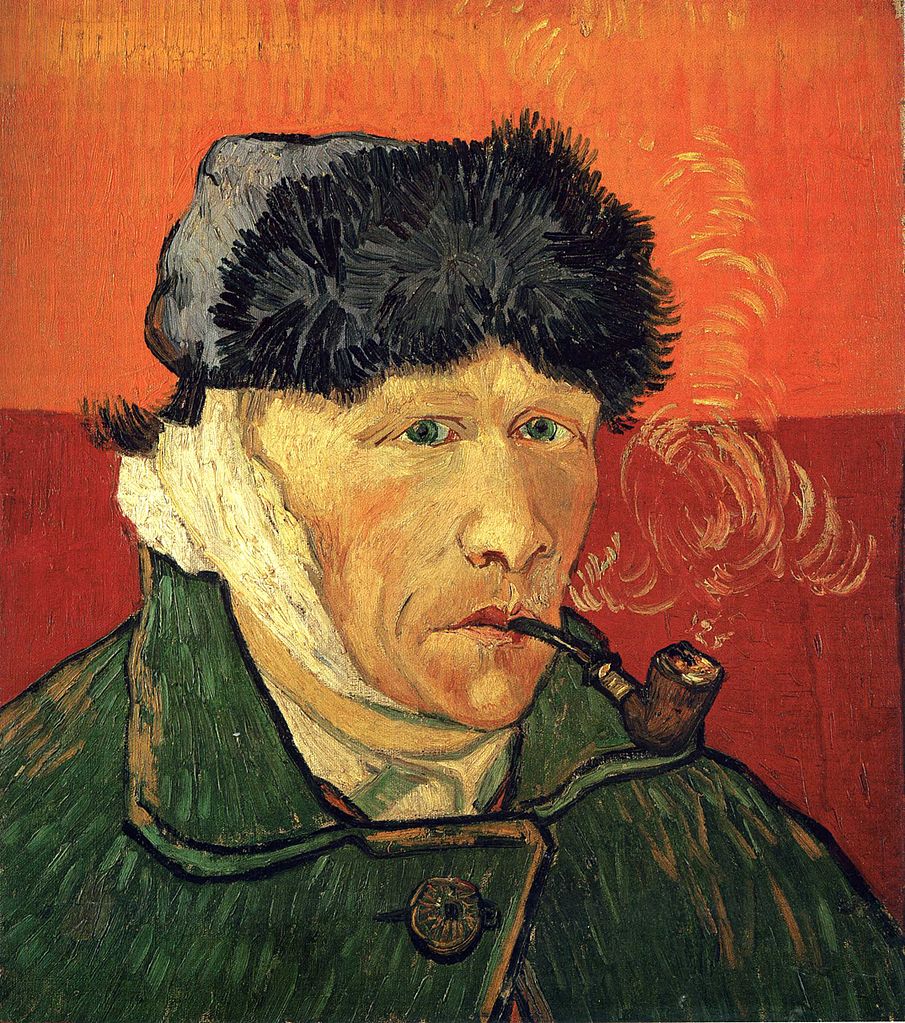Vincent Van Gogh was an admired artist, who was also a troubled and “tortured genius.” His artwork, Starry Night, Bedroom in Arles, and many others have earned him fame and recognition as one of the greatest artists of his time. But what many remember most about this artist is the story of his severed ear. Although his art is exemplary, his struggle with mental health and self-harm is admirable. His struggle was overlooked due to his incredible talent. He was successful as an art dealer, but as an artist, he had to prove himself with the headquarters of international art dealers, Gopil & Cie. During his lifetime, Van Gogh was the poster boy for the image of starving artist. His artwork was not recognized until much later in his career, which could have been a leading cause of his major depression and anxiety.1
Van Gogh, born in the Netherlands, decided to start his career in Paris in the 1880s, where many of the age’s great artists also resided. He believed he could get recognition for his pieces through his younger brother, Theo, who made his living as an art dealer. His brother introduced him to many artists, including Georges Seaurat, Camille Pisatto, and Paul Gauguin. Upon meeting these successful artists, Van Gogh was greatly inspired by their work and began creating his own artistic style, beginning in 1883. Later the same year, Van Gogh rented a small house in Arles, in the south of France. Paul Gauguin and Van Gogh became close friends and later roommates. They consistently bounced ideas off of each other and created a strong friendship.2

Like many friendships, theirs was rocky, and they found themselves drifting apart. Gauguin had moved on to a different artistic style and was exploring other ideas. Van Gogh at the time, had been reciprocating signs of depression and mental health issues, but at the time, these symptoms were considered normal. When Gauguin decided to explore other art spectrums, it involved moving out of the house he and Van Gogh shared. He broke the news to his roommate about his intentions, and this evidently this made Van Gogh go over the edge. He did not take the news lightly and both men began verbally arguing. Van Gogh had disappeared for a few hours and when he returned to confront Gauguin, he had a razor blade in hand threatening to hurt Gauguin.3
During the confrontation, however, Van Gogh was hesitant to hurt his friend and decided to turn the blade on himself and completely cut off his ear. Gauguin left him bleeding and alone. Van Gogh bandaged his head and began drowning himself in alcohol. During this episode, he walked out of his home and into the streets where he found a prostitute. The ear that he had severed off of himself had been neatly wrapped in a cloth; since Van Gogh was still heavily intoxicated, he decided to present this token to the prostitute. Patiently, she ran off and alerted the police about her encounter and they immediately rushed to his home.4
Shortly before Christmas Eve, Van Gogh was found by police in his bed, partially conscious and with major blood loss. Authorities rushed him to the hospital where he surprisingly recovered. Meanwhile, Gauguin was brought into questioning, but gave no testimony on the incident. It was believed that Van Gogh had suffered a severe mental breakdown long before he had severed his ear, but that this created a ripple effect that led to lunacy. The real reason behind the infamous Van Gogh ear-cutting may never be known; Gauguin had promised Van Gogh a pact of silence on the situation in letters that they supposedly exchanged. 5

After the incident, Van Gogh was admitted into a psychiatric facility in hopes of recovering mentally and physically. The dramatic change was not helpful for such a troubled artist, and in July of 1890, Vincent Van Gogh ended his life with a revolver. Before his suicide, however, he created a very iconic painting, Self Portrait with Bandaged Ear 1889. Van Gogh intended to persuade his doctors that he was perfectly able to continue working and creating art by creating this self portrait. He presented his piece, leaving a trail of wonder for his supporters as to why he included certain details in this particular piece, mainly because he continued to paint himself in the same yellow house he and Gauguin shared. Doctors overlooked these details and allowed Van Gogh to leave the facility.6
The epidemy of many artists like Van Gogh is often associated with mental instability, drug use, and alcohol abuse. Van Gogh had an array of medical issues that were tied back to his coping mechanisms (alcohol abuse), and as a result, many did not understand the struggles he faced and degraded him as a person while idolizing his artistic talent. As said before, the real reason behind his mutilated ear will be unclear, but his work and talent will continue to inspire and educate.
- Adam Gopnik, “Van Gogh’s Ear,” The New Yorker, Literature Resource Center (January 4, 2010): 48. ↵
- “Who Really Cut Off Van Gogh’s Ear?” Weekend All Things Considered, Literature Resource Center, (May 2010). ↵
- “Who Really Cut Off Van Gogh’s Ear?” Weekend All Things Considered, Literature Resource Center, (May 2010). ↵
- Belinda Thomson, “Comparing lives: issues of balance in biographical writing,” Literature Resource Center, French Politics, Culture and Society 24, no. 2 (2006): 60. ↵
- Tim Suermondt, “All the Answers.” Literature Resource Ceter, Prairie Schooner 85, no.3 (2011): 47. ↵
- Tim Suermondt, “All the Answers,” Literature Resource Center, Prairie Schooner 85, no. 3 (2011): 47. ↵



170 comments
Nathalie Herrera
Although I have seen Van Gogh’s art works, I was not to familiarize with his mental illness background. Not only that, but the situation on why he cut off his ear. I had no idea that Van Gogh struggled greatly internally and with his roommate/friend Paul Gauguin moving out could tip him over the edge so harshly by cutting off his ear. Despite the rough path he endured he will still be considered one of the greatest artists, and keep inspiring others through his masterpieces.
Hailey Rodriguez
Van Gogh’s story is truly inspirational. It proves that is he could become such a well-named artist while struggling with his mental health and physical health issues, other people who may be more fortunate than he can do amazing things as well. I have learned about his artwork and his background story, however, I did not know that his severed ear was a cause of his struggle with mental illness.
Donte Joseph
In all my years of schooling, I had never been required to look up information on Van Gogh, but I always admired his work. This article gives great information for others who like me were not known to the hardships in terms of mental illness he suffered. It is very sad to say that he had to die to get recognition for his amazing art, but this way he is always remembered for what he has left behind.
Pedro Gonzalez Aboyte
I learned about Vincent Van Gogh in 6th grade in one of my art classes. Back then, I only knew of his Starry Night painting and nothing more. As I got older, I learned more and more about the life of Van Gogh and how he struggled with mental illness. This article does a very good job of telling the importance of the episode he had where he cut his own ear off. It helps us understand that Van Gogh was very ill and didn’t get the help he needed. He was a very talented artist and it is a shame that that was the way he had to go, and it took death for his paintings to be recognized as masterpieces.
Pamela Callahan
I, probably like most people, have learned about Van Gogh on a general level. I knew he was an artist and that he painted Starry Night, but that was pretty much the extent of my knowledge. This article really taught me a lot about the artist that I didn’t know. I had no idea that Van Gogh struggled with mental illness in the ways that he did, but I find it inspirational that he was still able to complete such amazing works of art despite his challenges. This just goes to show that we shouldn’t judge people’s capabilities based on what we see on the exterior, because sometimes a person’s drive and desire to succeed can help them accomplish so much more than we, or even they, think.
Damian Jennings
Van Gogh is an artist that I thought I was familiar with but after reading this article I have been misinformed about his metal health and emotional status. His brother Theo, introduced him to several artists, one who would become Van Gogh’s close friend and roommate. Of course discussions turned into altercations, Van Gogh elevated the situation by pulling out a razor and threatening to hurt Paul Gauguin. Van then turned the razor to himself, cutting off his ear and was left on the floor bleeding out, intoxicated, and hysterical. I learned that he was admitted into a psychiatric facility and was freed after showing progress with a paint. He would end his life with a revolver in July of 1890.
Rylie Kieny
I studied Van Gogh and many of his pieces while taking AP Art History in high school. My teacher explained to us his continuous battle with mental illness and how it appeared in his work. This article does a good job brining to light this false idea that someone who has a great talent or finds great success cannot face struggles.It shows that event the greatest of the great can still struggle emotionally and mentally. I knew the story of the severed ear however I did not know that it was during an altercation with one of his friends. I also like how the article added there could be missing part of the story according to letters between the two men. This adds mystery to the story that leaves readers with many questions.
Mariana Valadez
I have been learning about Vincent Van Gogh’s art, however, I did not know about his health issues. It makes me intrigued to know why he severed his ear. He is one of the most known artist, but I am sure most people don’t know about his history of mental illness. I was completely unaware he had cut off his own ear. This article was very interesting and entertaining to read.
Lynsey Mott
I love Van Gough’s art work. I think I mostly knew what he suffered with is because he gets portrayed a lot in movies and shows. The one I got a lot of information on him and knowing that he had a mental illness was Doctor Who. They have done a wonderful job portraying him and his illness. He lived for his art work, and the fact that no one really appreciated it, sent him spiraling into his depression, and this article shows how much it affected him. How much it showed that because he wasn’t get recognition he got, his depression got ahold of him and led to his suicide. Its sad that after his death, it then gets recognized.
Stephanie Silvola
I knew of Van Gogh’s artwork and how famous he is/was. He is considerably one of the most known artists that is influential in the Art world. Although knowing about his artwork, I did not know his life story and history of mental illnesses. In fact, I did not know that he even cut off his own ear. Van gogh’s art was interepted as anything but depressing in my opinion. The fact that his artwork was undreappreciated and caused him to go into depression tells us that he lived for his artwork. This article was very informative about his medical issues and how, despite being depressed and coping wrongly with it, still created beautiful art pieces.